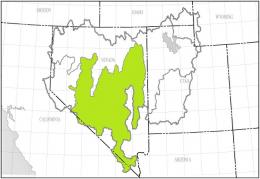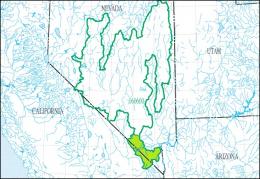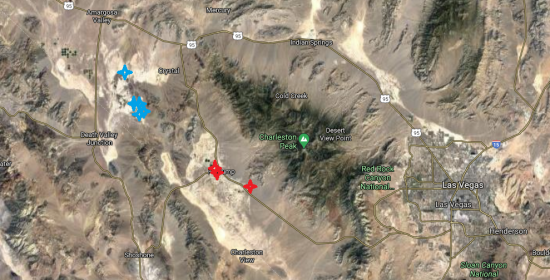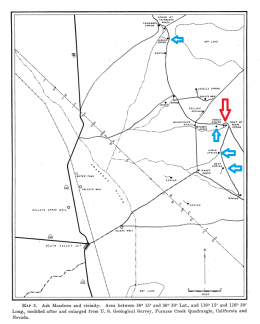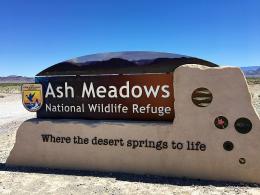Empetrichthys merriami
GILBERT, C. H. (1893): Report on the fishes of the Death Valley expedition collected in southern California and Nevada in 1891, with descriptions of new species. North American Fauna Nr. 7, part II, Washington: pp 229 - 384
Collection-number: United States National Museum, Cat. No. USNM-131151.
The Holotype is an adult female of 67mm standard length, collected by Theodore Sherman Palmer on March 4th, 1891. Eight Paratypes were collected, two more by Palmer (USNM-46102), five by Albert Kenrick Fisher (USNM-46101 and SU-766) and the last one by Edward William Nelson (USNM-46102) from the Pahrump Valley, this last one lateron recognized as being conspecific with its sister species Empetrichthys latos.
The left picture shows a drawing of the Holotype of Empetrichthys merriami from Gilbert's description, the picture in the middle a drawing of an immature male (UMMZ-140467), 20mm long from Eagle Spring, Ash Meadows, Nye County, and the right picture a photo from Francis W. Ouradnik of an adult male (UMMZ-140467), 34mm long from the same spring:
According to Leo Shapovalov (1941) in Miller (1948), the type locality of this species is the Point of Rocks or Kings Spring, Ash Meadows, Amargosa Desert, on the boundary between California and Nevada, Nye County, Nevada, USA.
This species is named in honour of the organizer of the Death Valley Expedition, the zoologist Clinton Hart Merriam.
The genus was erected by Gilbert in 1893 and the generic name can be derived from the ancient Greek. The word ἔμπετρος (émpetros) means "into the rock" with the prefix ἔμ- (én) meaning into and πετρος (petros) the rock. The last part of the word ἰχθύς (íchthús, íchthýs) is the Greek word for fish, herewith the generic name can be translated with "fish that lives (or hides) in rocks" or "fish that dashes into the rocks", literally "into the rock-fish".
none
The Ash Meadows Poolfish was endemic to the State of Nevada. Miller reported this species from five springs separated from each other by 20km beeline in Ash Meadows, Nye County, namely Deep Spring (also known as Eastern or Bole's Spring), Eagle Spring (or Big Spring), Point of Rocks Spring (or King Spring, type location), Forest Spring (or Forest Pool) and Hidden Spring (Rogers Spring). The Recovery Plan of the endangered and threatened species of Ash Meadows (1990) mentions additionally Fairbanks and Crystal Springs. A detailed map is shown in the chapter "Remarks".
ESU ist short for Evolutionarily Significant Unit. Each unit expresses an isolated population with different genetic characteristics within one species. ESU's can be defined by Molecular genetics, Morphology and/or Zoogeography and help in indicating different phylogenetic lineages within a species. The abbreviation for an ESU is composed of three letters of the genus, followed by the first two letters of the species name and an ongoing number in each species.
In the subfamily Empetrichyinae, no ESU's were in use so far. To align with the livebearing subfamily Goodeinae, the GWG wants to bring a system in use based on John Lyons' naming for this subfamily. As poor material from different springs was collected and no subspecies were distinguished ("There may be some local differentiation in the populations of the different springs, but the material now available is insufficient to determine whether the observed variations are significant", Miller 1948), for Empetrichthys merriami only one ESU, Empme1 is in use. With the last specimen seen in 1948 and all surveys since the early 1950's failing, it has to be regarded extinct.
The left map shows the Central Nevada Desert Basins Accounting Unit (HUC 160600) of the Great Basin Region (HUC 16), the right map the Ivanpah-Pahrump Valleys Cataloging Unit (HUC 16060015). The names of watersheds here in use are the ones officially used by the the U.S. Geological Survey:
International Union for Conservation of Nature (IUCN): Extinct
U.S. Fish & Wildlife Service (ECOS): Not Listed
Ash Meadows encompasses a number of springfed ponds and wetlands at the edge of the Mojave desert, most of them draining into the periodic and endorheic Amargosa River. The springs' temperatures range from 21 to 33°C, though annual fluctuations of temperature are only 2- 7°C within each spring. The submerge vegetation consists of stoneworts of the genus Chara and filamentous algae. Most of the pools are lined with emergent cattails (Typha spp.). Empetrichthys merriami prefered deeper pools (~ 2m) and was rarely seen in shallower areas.
In the following lines, we give R. R. Miller the chance to describe himself the five springs where he was able to find the Ash Meadows Poolfish: "Deep Spring is about 50 feet (15.2m) in diameter and of unknown depth, lies on the dry, alkali flat of the southern part of Ash Meadows. Its temperature (1939 and 1942) is about 27°C. The elevation here is somewhat less than 2200 feet (670m). Deep Spring is so named because it is considered to be the deepest in Ash Meadows-certainly not less than 30 feet (9.1m). The water is clear, chalky blue, with a sulfurous odor. Vegetation noted in 1942 was dense algae, Chara, Najas marina, a fine-leaved Potamogeton, Typha, Carex, and Eleocharis. The bottom along the marginal shelf of the south side consisted of silt, mud, and thick Chara. Eagle Spring lies about 1 mile (1.6km) north of Deep Spring at an elevation slightly less than 2200 feet (670m). It is about 20 feet (6.1m) in diameter, nearly circular, and approximately 8 feet (2.4m) deep. Although there are 2 outlet ditches, 1 to the south and 1 to the northwest, only the main outlet is shown on the map. The water is clear but very easily roiled because of the silt bottom and has a slightly sulfurous odor. Vegetation present in the spring in 1942 was green algae, Najas marina, and Chara. The shore was a marshy meadow of Eleocharis, Scirpus, and mesquite trees. The current was very slight. The temperature (1942), very similar to that of Deep Spring, was 27.6° C. The main spring at Point of Rocks is the most northerly of a series of spring heads at this locality. It is about 30 feet (9.1m) long, 2 to 6 feet (0.6-1.8m) wide, and not over 1.5 feet (0.45m) deep. The clear water, rather easily roiled, contains some green algae, and the pool is margined by Scirpus. The bottom consists of silt, sand, marl, and rocks. The water is rather shallow, from a few inches to 1.5 feet (0.45m) deep, At the pool outlet the current is extremely swift. The temperature varies narrowly between 31.1 and 31.8° C. The spring water has a high content of calcium, magnesium, and bicarbonates, but is of low salinity. Forest Spring, this remarkable spring, also called Forest Pool, is 0.7 miles (1.1km) west of the main spring at Point of Rocks and directly east of Tubb's Ranch. It lies 10 or more feet (3m) below the level of the surrounding desert flat and is without surface outlet. The water level, which fluctuates slightly between winter and summer, lies fully 10 feet (3m, formerly 13 feet, 4m) below the level of the adjacent desert flat. The pool is about 75 feet (22.9m) in diameter and deepens abruptly from the edge to an unknown depth. Great beds of Najas marina grow in the clear water, and there is a dense growth of green algae along shore. In 1942, samples of Utricularia were also present and Scirpus was growing about the margin of the pool. The bottom along shore is composed of fine sand, silt, and mud, much of which is probably washed into the pool during heavy rains. The banks are rather steep clay bluffs. The temperature of Forest Spring varies little. On January 9, 1939, it was 26.0° C. at 10:15a.m., with the air at 12.0°C; on September 28, 1942, at 4p.m., it was 26.7°C, the air 29.5°C. In comparison with the other springs analyzed in Ash Meadows, the waters of Forest Spring are higher in boron, lower ia calcium and magnesium, and have a somewhat greater salinity. Hidden Spring lies about a mile (1.6km) southeast of Fairbanks Ranch and is surrounded by a dense border of Scirpus. The spring head is about 8 by 3 feet (2.4 by 0.9m) and 10 feet (3m) deep, and its water temperature in September, 1942, was 28.0°C."
Observations in the habitats were rare and despite of this fish species obviously prefering deeper parts of the spring pools in contrast to the sympatric Cyprinodon nevadensis mionectes, almost nothing is known. From its congener Empetrichthys latos is known, that the spawning at the type location occured from January to July, with a peak in April or later in several habitats. Females move to remote areas of springs during the breeding periods (Kobetich et al., 1980). Eggs usually hatch in 7-10 days with an average length of the fry of 6.2mm. The average brood size was 123 (+/- 17) in allopatric setups under laboratory conditions (Goodchild, 2012).
Gilbert described conic and fixed teeth, arranged in each jaw in a band consisting of two or three rows, the outer series somewhat enlarged. Together with rather short intestines of about 1.5 times the length of the body, Empetrichthys merriami was probably and opportunistic omnivorous fish with tendency to feed mainly from animalistic sources.
There is no description of the colouration of live animals known. Gilbert wrote 1893: "In spirits the color is dark brown above, sides and below lighter, often irregularly blotched with brown and white. The belly often appears checkered, having centers of scales brown and margins white, or the reverse. Fins all dusky, the basal portions of dorsal and caudal with elongated brown spots on the interradial membranes."
Males and females of this species were for sure not easy to distinguish with males probably (like in its congener) being more slender and smaller than females. There are no documents talking about any colour differences of sexes.
R. R. Miller (1948), when describing Empetrichthys latos, regretted the rareness of its sister taxon. During a six year period of sampling fish from 1936-42 in the Amargosa River drainage, he had been able to collect only as few as 22 specimens out of the known five springs with additionally 16 more in total collected by Joseph Howe Wales and George Sprague Myers in the 1930's. The last specimen of this species was collected in September 1948 from Big Spring by John Kopec and W. H. Hildmemann, attempts in 1953 by Otto M. Sokol already failed, so it is believed to have gone extinct in the early 1950s, likely as a result of habitat alteration and competition with and predation by introduced nonnative crayfish (Procambarus clarkii), mosquitofish (Gambusia affinis), Mollies (Poecilia sphenops), and bullfrogs (Rana catesbiana).
Poolfish occured exclusively in an area 50 to 100km west and northwest of Las Vegas. The map below shows the historic places where the genus Empetrichthys occured with red asteriscs marking the habitats of Empetrichthys latos in the Pahrump Valley, blue those of Empetrichthys merriami in Ash Meadows. A low rise separates both basins:
The left picture shows a map of the Amargosa desert area with the type location (Point of Rocks Spring) marked with a red arrow, the other four springs described by Miller are marked with blue arrows, the right picture shows the entry sign of the Ash Meadows National Wildlife Refuge. The recovery plan of the endangered and threatened species of Ash Meadows (1990) mentions additionally Fairbanks and Crystal Springs (not marked on the map) as orgininally populated with Empetrichthys merriami, but not Deep Spring:
In 1984, much too late for Empetrichthys merriami, the Ash Meadows National Wildlife Refuge was established to protect the endangered endemic plant and animal species of this area, including the famous Devil's Hole Pupfish (Cyprinodon diabolis), two subspecies of the Amargosa Pupfish, Cyprinodon nevadensis (mionectes and pectoralis), and the Ash Meadows Speckled Dace, Rhinichthys osculus nevadensis.
Carl Hubbs (1932) when describing Crenichthys nevadae, unrolled a bit what was known about the relationship of the genus Empetrichthys before it was finally discovered of being related with the Mexican Splitfins. Here his thoughts: "In describing Empetrichthys, Gilbert (1893) remarked that it "seems most nearly allied to Orestias, of which numerous species have been described from lakes in the high Andes of South America. " Garman (1895) regarded the genus as "allied to Fundulus through the more compressed species," though he approximated and compared Empetrichthys with Orestias in his key. Jordan and Evermann (1896) placed Empetrichthys in the Orestiinae. Eigenmann (1920) commented at some length on the possible relationships of the two genera, concluding that: They are so similar that they might readily be considered as forming but one genus. The double series of teeth in the jaws and the terminal though oblique mouth and the slightly more posterior position of the dorsal are the only characters distinguishing Empetrichthys from all of the species of Orestias. Myers (1931) finds, however, that Empetrichthys lacks skeletal features supposed to characterize the Orestiatinae (Orestiinae), and concludes that "it appears to have nothing to do with Orestias." Species of the subfamily Empetrichthyinae are oviparous fishes and share the lack of pelvic fins, while the subfamily Goodeinae is livebearing. Lynne Parenti (1981) finally proposed this subfamily as sister group to the Goodeinae and encompassed both in the family Goodeidae. Meanwhile the monophyly of the family Goodeidae and the narrow relationship between both subfamilies has been supported through several studies since the 1980's and is not doubted any longer, and meanwhile science is sure, that the resemblance of the genus Orestias is only superficial.





